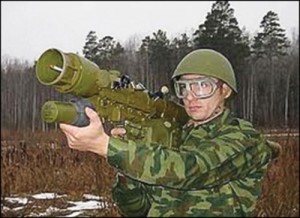Surface-to-air (SAM) missiles. Short- to medium-range missiles used in the air defence role against attack helicopters and aircraft are the most common surface-to-air missiles that use IR homing guidance. A large proportion of these missiles belong to the category of MANPADS. Some of the more common and better known IR-guided surface-to-air missile systems are Stinger, Igla (Igla and Igla-1) and Strela (Strela-2 and Strela-3).
FIM-92 Stinger is a man-portable IR-guided surface-to-air missile designed by General Dynamics and manufactured by Raytheon Missile Systems in the USA, in Germany by European Aeronautic Defence and Space Co. (EADS) and in Turkey by ROCKETSAN. It entered into service in 1981 and continues to be in service till date. It is adaptable to be shoulder fired [Fig. 16(a)] or from land vehicles [Fig. 16(b)] as surface-to-air missile and helicopters as air-to-air missile. Stinger missile has evolved over the years and has undergone significant technological improvements.
Three main variants of stinger include FIM-92A, FIM-92B and FIM-92C. These are known by the names of Stinger basic (FIM-92A), Stinger passive optical seeker technique or Stinger POST (FIM-92B)], and Stinger reprogrammable microprocessor or Stinger RMP (FIM-92C).
Stinger is intended to fulfil short-range air defence (SHORAD) role till 2018. It consists of a

Stinger round encased in a launch tube and separates a grip-stock assembly. Stinger basic employs an IR seeker. Stinger POST uses a dual IR and UV seeker, thereby providing higher immunity to countermeasures as compared to Stinger. Stinger RMP is so-called because of its ability to load a new set of software via an ROM chip inserted in the grip at the depot. The missile has maximum effective firing range of 4.8km and maximum speed of 2.2Mach (750m/s).
Stinger made its debut in warfare in 1982 during Falklands war between the UK and Argentina. Subsequently, it was used in the Soviet War in Afghanistan, Angolan civil war, Libyan invasion of Chad, Chechen War, Sri Lankan civil war and Syrian civil war.
Russian Igla is a MANPADS manufactured by KBM. The missile has a maximum operational range of 5.2km and a peak speed of 800m/s. It has three variants, namely, 9K310 Igla-1E (NATO designation SA-16 Gimlet), 9K38 Igla (NATO designation SA-18 Grouse) and 9K 338 Igla-S (NATO SA-24). Igla missile system was inducted into service in 1981, and its different variants developed over the years continue to be in service till date.
9K310 Igla-1 with its 9M313 missile uses liquid nitrogen cooled indium-antimonide IR seeker head. 9K38 Igla with its 9M39 missile was inducted into service in 1983. It used liquid nitrogen cooled indium-antimonide and uncooled lead-sulphide IR seeker head that has higher sensitivity and improved resistance to countermeasures and jamming.
Igla-S (SA-24 Grinch) shown in Fig. 17 is the latest generation of portable air defence missile system designed to target visible aerial platforms, such as helicopters, tactical aircraft, unmanned aerial vehicles and cruise missiles. It is an improvement over earlier SA-16 and SA-18 versions. It employs a dual-band IR seeker and has a maximum engagement range of 6km as compared to 5.2km in the case of SA-16 and SA-18. It also uses a heavier warhead, which allows it to destroy the target even if it misses the target by 1.5m.
Strela family of missiles is man-portable surface-to-air missiles that use passive IR homing guidance and a high explosive warhead. Different members of the family are 9K31 Strela-1, 9K32 Strela-2, 9K34 Strela-3 and 9K37 Strela-10. Strela-1 is commonly known by its NATO designation SA-9 Gaskin and is a short-range, low-altitude, self-propelled SAM-carrying system based on the BRDM-2 chassis, an amphibious patrol car mounting two pairs of ready-to-fire 9M31 missiles. The missile has a maximum operational range of 4.2km and speed of 1.8Mach. It uses a lead-sulphide IR seeker.
9K32 Strela-2 (NATO designation SA-7 Grail) is a man-portable, shoulder-fired, low-altitude surface-to-air missile system with maximum firing range of 3700m (Strela-2) and 4200m (Strela-2M). It was inducted into service in 1968. SA-7 Grail is a tail-chase missile system whose efficacy depends on its ability to lock onto the heat source of low-flying fixed and rotary-wing aircraft. The simple IR seeker mechanism of the missile is easily prone to simple countermeasures and environmental effects.
9K34 Strela-3 (NATO designation SA-14 Gremlin) was developed to overcome the shortcomings of its predecessor Strela-2. 9M36-1 missile of SA-14 Gremlin used a new IR homing seeker that was less vulnerable to jamming and decoy flares as compared to SA-7 Grail. It has a maximum operational range of 4.5km and average supersonic speed of 410m/s.
9K35 Strela-10 (NATO designation SA-13 Gopher) was designed to replace Strela-1. It was an improvement on Strela-1 and had an effective firing range of 5km. The 9M37 missiles of Strela-10 used a higher quality IR seeker than was used in 9M31 missiles of Strela-1 system.






